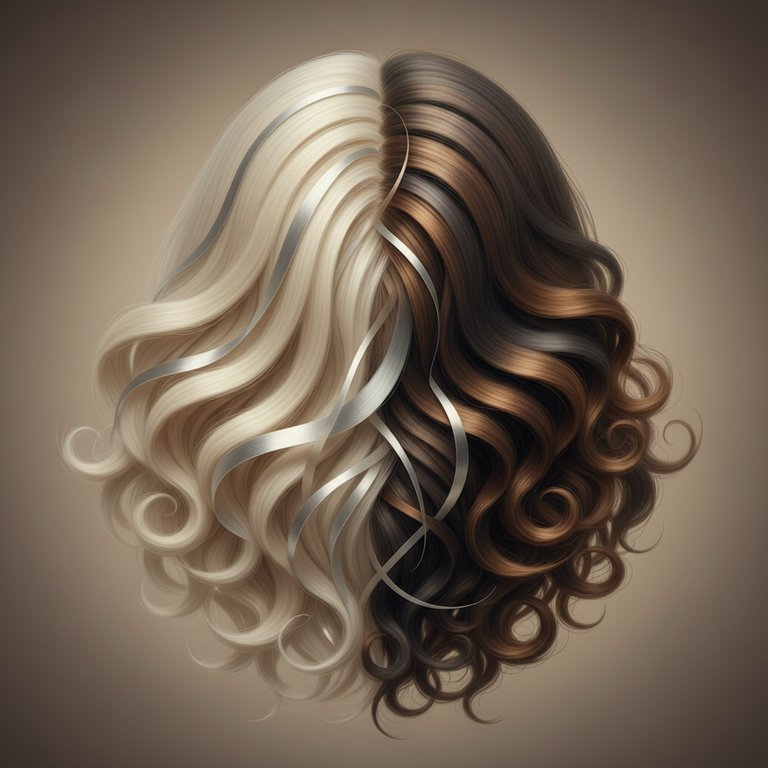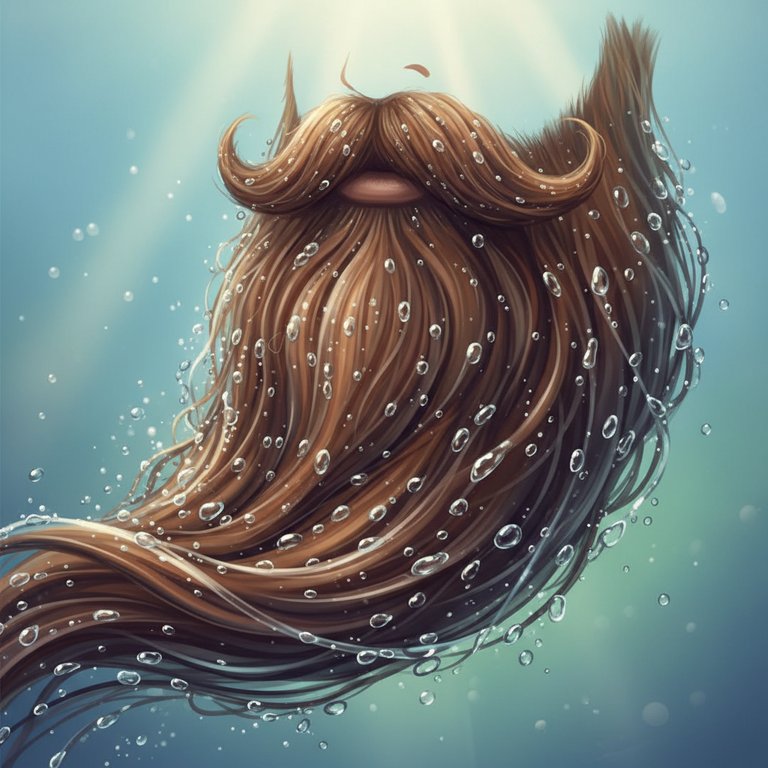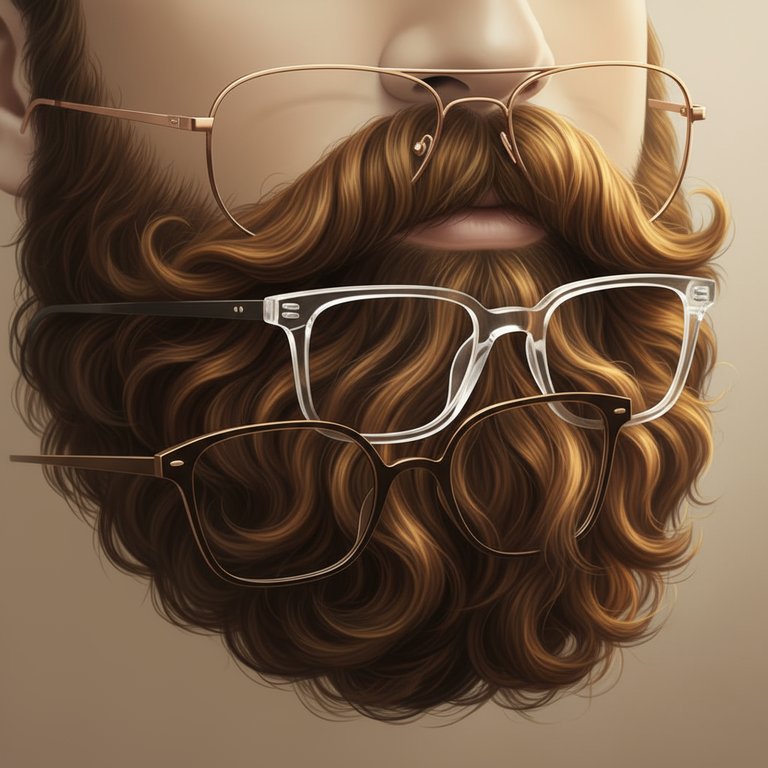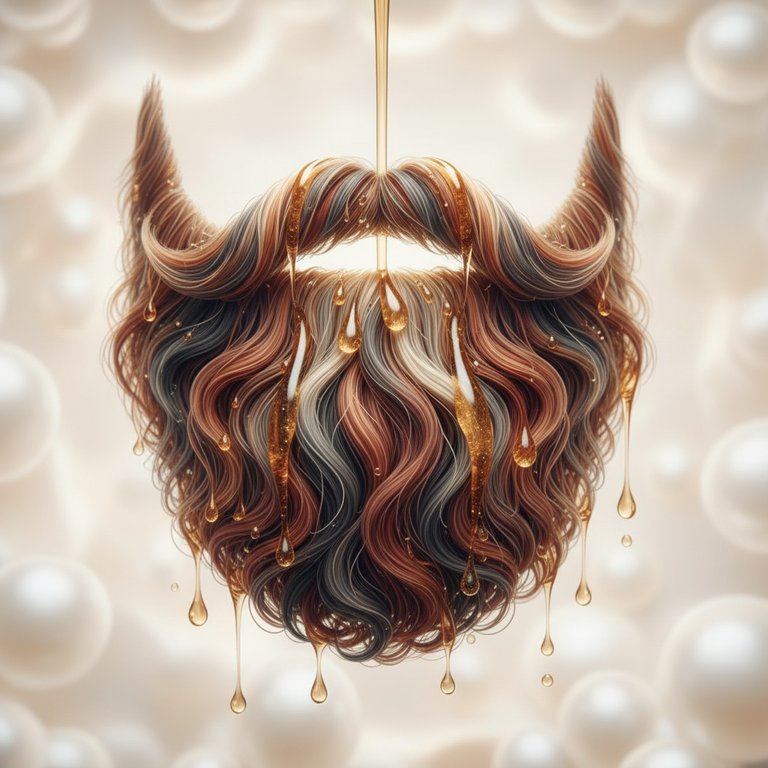Hey there, fellow beard enthusiast! Ever look in the mirror after a good wash and think, "What in the world is going on here?" One minute, your magnificent mane feels soft and straight on top, perfectly cascading down. The next, you notice a wild, untamed jungle of waves and curls lurking underneath, almost like a secret party happening without your permission. If this sounds familiar, you're definitely not alone. It's a super common beard conundrum, and honestly, it can be a bit frustrating when you're aiming for a consistently neat look.
That feeling of a perfectly straight top layer contrasting with a rebellious, wavy underbelly? Yeah, we've all been there. It’s like your beard has a split personality! But don't you worry, my friend. This isn't some strange beard curse. There are perfectly logical reasons why your facial hair might be behaving this way, and more importantly, there are plenty of awesome styling solutions to help you achieve a more uniform, well-groomed look. Consider me your personal beard guide on this journey to understanding and taming your unique facial fuzz.
In this comprehensive guide, we're going to dive deep into the mysteries of your beard's texture. We'll explore why this wavy-underneath, straight-on-top phenomenon happens, and then arm you with practical, step-by-step styling techniques, pro tips, and answers to some of the most common questions beard growers have. Get ready to unlock the secrets to a beard that looks consistently fantastic, from top to bottom!
Understanding Your Beard's Unique Nature
Before we jump into fixing anything, it's super important to understand why your beard might be doing what it's doing. Think of your beard as a mini ecosystem on your face – it's influenced by so many factors!
The Genetic Blueprint
First things first: genetics play a huge role. Just like the hair on your head, the hair that makes up your beard is largely determined by your DNA. Some folks have naturally straight hair, others have wavy, and many have curly. It's not uncommon for different parts of your body to have different hair textures. Your beard is no exception! You might have genes that dictate straighter hair growth on your cheeks and chin (the top layer) and curlier, more robust hair underneath, closer to your neck.
Hair Follicle Direction and Growth
Another key player is the direction your hair follicles grow. Hair doesn't just sprout straight out; each follicle has a specific angle. If the follicles on the top of your beard are growing in a relatively uniform, downward direction, you'll likely see straighter hair. However, underneath, especially around the jawline and neck, follicles can often grow in various directions, sometimes even swirling. This criss-cross pattern can lead to hair strands intertwining, causing them to appear wavier or curlier.
The Role of Hydration and Environment
Believe it or not, the environment and how well you hydrate your beard can also influence its texture. Dry, brittle hair is more prone to frizz and can accentuate any natural wave or curl. If the underneath sections of your beard are less exposed to moisture (either from products or or just ambient humidity), they might dry out more, leading to a wavier appearance. Plus, friction from clothes or even just sleeping can rough up the hair cuticles, making waves more pronounced.
Why the Top is Straight and the Underneath is Wavy
So, we know the general reasons for hair texture, but why the distinct difference between the top and bottom of your beard specifically? Let's break it down.
Different Hair Types on the Same Face
This is probably the biggest culprit. It's totally normal for the hair on your face to have varying textures. The hair on your cheeks might be finer and straighter, while the hair on your chin or neck might be coarser and prone to curling. As your beard grows longer, these different textures become more apparent, especially when they lay over each other.
Length and Weight Dynamics
Think about gravity! The longer your beard gets, the more weight it carries. This weight tends to pull the outer, longer strands downwards, making them appear straighter. The hair underneath, however, might not be as long or might be growing in a direction that prevents it from being pulled down as effectively. It also has less "outer layer" pressure, allowing its natural curl or wave to spring up more freely.
Product Application and Styling Habits
Be honest, how do you usually apply your beard oil or balm? Most of us tend to focus on the outer layer, right? We rub it in from the top, perhaps not always ensuring it penetrates deep down to the hair closest to the skin and underneath the bulk of the beard. This uneven product distribution means the top gets more conditioning and hold, helping it stay straight, while the underneath might be left to its own wavy devices. Similarly, when you brush or comb, you might naturally smooth the top more vigorously than the hidden layers.
The Hidden Beard: Neglected Undergrowth
The hair underneath your beard is often the most neglected. It's harder to see, harder to reach, and sometimes, we just forget about it! This undergrowth can be prone to tangles, dryness, and a lack of consistent grooming, all of which contribute to it appearing wavier and less manageable than the well-cared-for top layer.
Taming the Texture: A Step-by-Step Styling Guide
Alright, now that we understand the 'why,' let's get to the 'how'! Here's a step-by-step guide to help you achieve a more uniform and polished beard, even with those stubborn waves underneath.
Step 1: The Right Wash and Condition
Start with a clean slate. Use a good quality beard wash and follow up with a nourishing beard conditioner. When conditioning, make sure to really work it into all parts of your beard, especially those underneath sections. Let it sit for a few minutes to allow the hair to soak up the moisture. Rinse thoroughly but gently.
Step 2: Towel Dry Gently
After washing, gently pat and squeeze your beard with a soft towel. Avoid rough rubbing, as this can create frizz and disrupt the hair cuticle, making waves more prominent. You want your beard to be damp, not dripping wet, before the next steps.
Step 3: Apply Your Elixirs (Oil & Balm)
This is crucial for hydration and control. First, apply a few drops of beard oil. Dispense it into your palms, rub them together, and then work it through your entire beard. Really get in there! Massage it down to the skin and ensure the underneath sections are thoroughly coated. The oil helps moisturize and soften the hair. Next, take a small amount of beard balm. Warm it between your palms and apply it similarly, focusing on coating all strands. Balm provides a light hold and helps to train the hair.
Step 4: The Blow Dryer & Brush Combo
Now for the styling magic! Grab your blow dryer (on a low to medium heat setting) and a good quality beard brush or comb. I personally prefer a brush with natural bristles as it helps distribute natural oils and smooth the hair. Start by brushing your beard downwards and outwards while blow-drying from the top. Then, focus on the underneath sections. Use the brush to pull these wavy hairs downwards and outwards, directing the warm air from the blow dryer along the path of the brush. This technique helps to relax the natural curl and encourages the hair to lie flatter. Repeat this process until your beard is mostly dry and you've achieved your desired shape.
Step 5: The Finishing Touch
Once your beard is dry and styled, apply a small amount of beard butter or a finishing balm for extra nourishment and a light, natural hold. Use your hands to smooth down any flyaways and ensure all sections are lying flat. A final gentle brush can help set everything in place.
Pro Tips for a Harmonious Beard
Beyond the daily routine, here are some extra nuggets of wisdom to keep your beard looking its best:
- Consistency is Key: Don't expect overnight miracles. Consistent grooming, especially with the blow dryer and brush technique, will gradually train your beard hairs to lie in the desired direction.
- Don't Overdo the Heat: While a blow dryer is great for styling, excessive heat can damage your beard. Always use a low to medium setting and keep the dryer moving.
- Regular Trimming: Even if you're growing it out, regular, light trims are essential. Trimming away split ends and maintaining a consistent length (even if it's just a tiny bit) can make a huge difference in how your beard lays. A professional barber can also help shape it to minimize the wavy effect.
- Sleep Smart: If you're a restless sleeper, your beard can get pretty messed up overnight. Consider sleeping on a silk or satin pillowcase. It reduces friction, which means less frizz and less disruption to your carefully styled beard.
- Experiment with Products: Not all beard oils or balms are created equal. Some offer more hold, others more moisture. Don't be afraid to try different generic products until you find the combination that works best for your specific beard texture.
- The Power of a Straightening Comb: For particularly stubborn waves, a heated beard straightening comb (used carefully and sparingly) can be a game-changer. Always use it on a clean, dry, and oiled beard, and follow the instructions to avoid heat damage.
Your Beard Questions Answered: FAQs
Can I really change my beard's natural texture permanently?
While you can't permanently alter your beard's natural genetic texture (if it's naturally wavy, it will always be wavy at its core), you can absolutely influence how it lays and appears. Consistent grooming, proper hydration, and styling techniques like blow-drying and brushing with generic beard products can train your beard hairs to lie straighter and smoother, giving the appearance of a changed texture. It's more about managing and styling than a complete overhaul.
How often should I use heat on my beard to straighten it?
Using a blow dryer or heated straightening comb daily is generally fine, provided you use a low to medium heat setting, keep the tool moving, and always apply a good beard oil or balm beforehand for protection and hydration. Excessive, high heat without protection can lead to dryness and damage over time. Listen to your beard – if it starts feeling brittle or looks dull, dial back the heat or increase your conditioning routine.
What's the difference between beard oil and beard balm for taming waves?
Think of them as a dynamic duo! Beard oil is primarily for conditioning and moisturizing both your beard hair and the skin underneath. It softens the hair, making it more pliable and less prone to frizz. Beard balm, on the other hand, contains oils and typically a wax component (like beeswax) which provides a light to medium hold. For taming waves, the oil softens them, and the balm helps to lay them down and keep them in place. Using both together gives you the best of both worlds: hydration and control.
My beard gets really frizzy after I wash it, especially the wavy parts. What can I do?
Frizz often happens when the hair cuticle is open and absorbing too much moisture from the air, or when hair is dry and damaged. To combat this, ensure you're using a hydrating beard conditioner. After washing, gently pat your beard dry with a soft towel – never rub vigorously. Immediately apply beard oil to lock in moisture and smooth the cuticle. Using a blow dryer with a brush, directing the air downwards, can also help seal the cuticle and reduce frizz as it dries.
How long does it take to train my beard to be less wavy?
This really depends on your individual beard's natural texture and growth patterns. Some guys notice a difference within a few weeks of consistent grooming, while for others, it might take a couple of months to see significant results. The key is patience and consistency. The more regularly you apply products, brush, and use gentle heat to style, the more your beard will adapt to the desired direction over time.
Is it okay to trim my beard short if the wavy parts are bothering me?
Absolutely! If the waves underneath are truly becoming a nuisance, a good trim can definitely help. Shorter hair tends to be less prone to pronounced waves because there's less length for the curl to form and less weight to pull it down. You can either trim the entire beard to a shorter, more manageable length or ask a barber to specifically thin and shape the underneath sections to reduce bulk and waviness while maintaining length on top.
What if my beard is just naturally super curly underneath? Can I ever make it straight?
If your beard is naturally very curly underneath, achieving a perfectly pin-straight look might be challenging without constant, intense styling. However, you can certainly make it appear much straighter and more uniform. Focus on maximizing hydration with beard oil, using a strong-hold beard balm, and consistently employing the blow dryer and brush technique to stretch and smooth the curls. A heated beard straightening comb can also be very effective. Remember, the goal is often to harmonize the textures, not necessarily to eliminate all natural curl.
Conclusion
So there you have it, my friend! The mystery of the wavy-underneath, straight-on-top beard is no longer a secret. It's a common characteristic rooted in genetics, hair growth patterns, and even your grooming habits. But here's the good news: with a little understanding, the right generic products, and consistent styling techniques, you absolutely can achieve a more harmonious and well-groomed beard that you'll be proud to show off.
Remember, your beard is unique, and that's part of its charm. Embrace its quirks, but don't be afraid to guide it towards the look you desire. Experiment with the tips and steps we've discussed, find what works best for your specific facial hair, and enjoy the journey of mastering your magnificent mane. Happy grooming!
Disclaimer: The information provided in this blog post is for general informational purposes only and does not constitute professional advice. Always use grooming tools and products according to their instructions.



